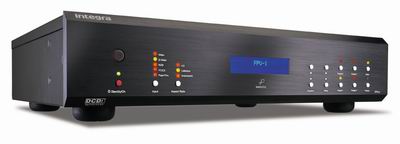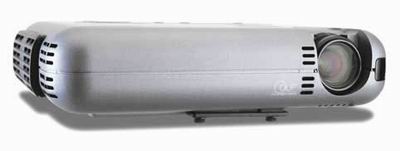The Integra DLV-100 and FPV-1 Video Projection System
| The Integra DLV-100 and FPV-1 Video Projection System |
|
Breaking Barriers in the Price slash Performance Arena |
|
Clement Perry |
|
12 September 2002 |
Specifications
FVP-1
Inputs: Composite (BNC), S-Video (4-pin), Component (BNC),
HD/Computer Pass (D15M)
Outputs: RGB.
Aspect Ratios: 4:3, Anamorphic, Letterbox
Controls: Brightness, Contrast, Color, Tint, Noise Reduction, Detail via RS-232 and direct access Infrared

Address:
Integra Research
18 Park Way
Upper Saddle River, NJ 07458
Phone: 800-225-1946
Fax: 201-785-2650
Website: www.Integrahometheater.com
Price: Total $8,000
The cost of building a home theater with a true theater quality picture – either two piece, rear projection or plasma – has dropped significantly over the past five years, while the quality of the components meant to project images on your screen has taken tremendous leaps forward. The auspicious arrival of DTV, HDTV and DVD answers some of the many questions as to why home theater has been such a rousing success. A major reason, of course, is the new lightweight and inexpensive technology developed by Texas Instruments called Digital Light Processing, or DLP.
In 1999, while attending the Stereophile Show, I got my first glimpse of the DLP technology. The presentation there was hugely successful, thanks in part to DVD’s (the quality of DVD made everything look better) increasing popularity. I jumped in with no reservations after seeing the Dream Vision DLP500, (with a list price of $6999 setting the industry on it heels) which I ultimately purchased, replacing my Toshiba 43″ widescreen. Since then the wide success DLP has gained in quality, reliability and size has grown dramatically. With High-Definition broadcast gaining steady momentum, DLP, HDTV and DVD have joined forces to create an unadulterated winning combination of technology and affordability in two-piece video projection setups. Especially if you stumbled, as I did, upon the newest offerings from Integra.

Integra’s first foray into the big-screen video business is the incredibly small DLV-100 DLP video projection system. Measuring a mere 9½ inches wide, 7¾ inches deep and 2 inches tall, and weighing only 3.3 lbs, it is possible to mount the DLV-100 almost anywhere. Because it uses a single DLP chip, it requires no complex color and image alignments, making it easy to install and setup. HDTV-ready, the DLV-100 produces an exceptionally clear and bright image when projected up to a maximum of 100 inches (measured diagonally). To take matters further, Integra teamed up with Faroudja Laboratories to co-produce and co-brand the external Integra FPV-1 Digital Video Processor. Most amazing is that both the DLV-100 and FPV-1 retail for the highly affordable price of $8000. You too, with one good look at this DLP projector, will understand why I call its asking price affordable.
HDTV ready and offering a contrast ratio of 800:1, the Integra DLV-100 boasts an XGA native resolution of 1024 × 768 with 1000 ANSI Lumens in Normal mode and 750-800 ANSI Lumens when operating in Long Life mode, which is stated to extend bulb life and provide quieter fan operation. Atop the DLV-100 are two LEDs (on/standby and status) while source, auto adjust, menu, cancel, select and enter buttons complete what looks like a well thought out design. The rear of the DLV-100 supports inputs for composite, S-Video, and RGB with computer ports making it PC friendly. A USB port allows for direct connection of a mouse for use with on-screen menus. Other features include Digital Zoom, a built-in slot for a Compact Flash card, and a presentation viewer for creating “slide shows” with images from a digital camera.
The Integra/Faroudja FPV-1 Digital Processor converts an interlaced signal into an unadulterated, high frequency 768p progressive signal that is a pixel-to-pixel match with the DLV-100. Personally witnessing Faroudja’s Native Rate scalers (NR) with the patented Cross-Color Suppression and 10-bit adaptive digital comb filter destroy one of those all-in-one units on a 50″ Pioneer was all the evidence needed to convince me of Faroudja’s superiority. With features like their patented Diagonal Correlation Deinterlacing, that rids ones picture of unwanted jagged-edged motion artifacts and their Edit-Detection circuitry with 3:2 pull-down that provides the smoothest possible images from film-based video sources, it’s no wonder why this two piece unit picture wowed me. The FPV-1 accepts component video, S-video, composite, and HD/computer inputs (VGA-style 15 pin) and has an RGB video output. Common user-friendly front-panel control features include brightness, color, contrast, tint, and selectable aspect ratios: 4:3 standard, 4:3-widescreen and 16:9 widescreen. Advanced setup options allow far more flexibility for picture controls, such as Y/C adjustments and horizontal-vertical sharpness, and far outdistance comparably priced DLPs in this area. An RS232 control port allows the processor to work with AMX, Crestron and other home automation systems. As most monitor only devices, the DLV-100 has no provision for dealing with audio.
Using the same tabletop positioning as the Dream Vision seemed optimal for setup for the DLV-100, while the FPV-1 found a comfortable spot in my rack. Once accomplished, which took all of fifteen minutes, the on-screen menu was easy to flip through via the hand held remote. The DLV-100 and FPV-1’s on-screen features are much more expansive than the Dream Vision, which by the way, makes it good and bad. Good if you know what you’re doing and bad because there’s much more settings to potentially screw up. One feature I desperately needed in the Dream Vision was keystone correction since I employ an ever-so slight tilt of the DLV-100 to center its picture on my 100-inch Da-lite screen. Unfortunately, this produces trapezoidal distortion and keystone correction is the perfect tool to keep the screen perfectly rectangular. The DLV-100’s digital keystone correction fixed this in a snap.
Demo after demo showed me this DLV-100/FPV-1 combo was, out of the box, quite an improvement over the first generation DLP chips. The DLV-100/FPV-1’s picture is much sharper, brighter and cleaner than the Dream Vision, even without the FPV-1. Viewing the DLV-100 through the FPV-1 took its picture quality considerably further. Watching the heart-wrenching Vietnam drama We Were Soldiersthrough the DLV-100/FPV-1 combo reveals the DLV-100/FPV-1’s marvelous image clarity. Blacks were noticeably blacker, creating greater overall contrast, while whites were shown with a brilliance that was quite impressive. Flesh tones appeared natural in both day and night scenes throughout this very intense film. The incredibly light output of the DLV-100/FPV-1 shows consistently throughout this film showing how brighter the newest DLP chip is, in general, and how excellent these two units perform together, in particular.
Watching the two-disc set of Steven Spielberg’s Artificial Intelligence, which boasts an excellent 1.85:1 anamorphic picture, showed even blacker blacks – as deep space scenes should appear – while maintaining excellent color saturation and detail. While not crazy about this futuristic sci-fi flick, I found the scenes hauntingly beautiful. Ditto, the Hughes Brother’s From Hell DVD. Though some scenes are quite grotesque, this take on Jack the Ripper, shot almost entirely at night, provides oodles of detail from this excellently transferred 2-disc set (2.35:1). When you can see the lapel and buttons on a black suit against the night, while maintaining proper reds and blues, you know you’ve got something special. While night scenes were rendered with aplomb, showing off this combo’s shadow detail, I did notice the overall color taking on a greenish hue during some day scenes
(ala The Matrix). This tells me that either this transfer isn’t a perfect one throughout, or this is exactly what the filmmaker had in mind. Using the DVD Video Essential disc showed you can get an exceptionally good picture with a little adjustments right out of the box, though professional calibration from an ISF trained pro is recommended.
Switching to an HDTV broadcast of HBO-HD using an RCA DTC-100 receiver through the FPV-1’s 15-pin VGA throughput connection was spectacular. For the first time under real world conditions with a system priced this modestly, could I see a picture of this quality and magnitude. The DLV-100/FPV-1’s level of clarity, color and detail easily surpassed even the best DVD’s I had. I use Sampo’s SME-34WHD5 16:9 HDTV downstairs and it shows a quite remarkable Hi-Def picture on its own 34-inch screen. However, after viewing HBO-HD on a near 100-inch diagonal screen with incredible resolution shows me size matters.
Kid Billionaire Mark Cuban, who recently purchased his own network on Direct TV (channel 199), boasts some of the most spectacular Hi-Def video clips I’ve seen come from a Satellite feed. The DLV-100 threw quite a three-dimensional picture in Hi-Def, and images appeared with greater focus and were incredibly crisp. Replays of the Winter Olympics, for example, showed the power and superiority of HDTV over virtually every reference DVD I own. Watching the speed skating tournament proved breathtaking for the eyes. As good as the speed skaters looked, what proved even more astounding was the shot of the audience when the Hi-Def cameras zoomed over them. To see a collage of thousands of people in colored sweaters, jackets and coats stand out so individually vivid and sharp, with no color bleeding or smearing, was breathtaking. This high level of quality isn’t isolated to Direct TV Satellite. NBC, CBS as well as PBS affiliates, have also joined in HDTV programming. Thanks to NBC-HD, The Tonight Show with Jay Leno has me hypnotized. There’s probably nothing more beautiful than the look of this broadcast when it comes to color saturation and picture quality. I sat, slack jawed, while watching Jay go through his monologue, which is no less corny, but the quality of the picture was the closest I’ve felt to peering through the proverbial window.
In closing, the Integra DLV-100/FPV-1 combo is more than a bargain for the big screen home theater buff. In my humble opinion, it’s a downright steal. It’s not perfect; the DLV-100 will exhibit a high level of fan noise. Nothing too distracting, but nonetheless noticeable on quiet scenes in a movie. That aside, the Integra DLV-100/FPV-1 combo serves as a clear and obvious reference for me where DLP technology is heading. The Faroudja FPV-1 will set you back about $4000 if purchased separately from Faroudja, and the DLV-100 will set you back $5,000 when purchased solo. So I ask you, for a total list price of $8000, how can you go wrong? More importantly, there’s nothing in a country mile that I’ve been exposed to that can equal the DLV-100/FPV-1’s versatility, simplicity, ease of setup and most importantly, picture quality. Nothing but accolades have been showered by everyone that has seen its picture. It transforms my listening room into a seriously good-looking home theater rig. Hey, somebody pass the M&M’s! The price of admission to your favorite flick just got a lot cheaper thanks to the folks at Integra.
![]()
Don’t forget to bookmark us! (CTRL-SHFT-D)
Stereo Times Masthead
Publisher/Founder
Clement Perry
Editor
Dave Thomas
Senior Editors
Frank Alles, Mike Girardi, Russell Lichter, Terry London, Moreno Mitchell, Paul Szabady, Bill Wells, Mike Wright, and Stephen Yan,
Current Contributors
David Abramson, Tim Barrall, Dave Allison, Ron Cook, Lewis Dardick, John Hoffman, Dan Secula, Don Shaulis, Greg Simmons, Eric Teh, Greg Voth, Richard Willie, Ed Van Winkle, Rob Dockery, Richard Doran, and Daveed Turek
Site Management Clement Perry
Ad Designer: Martin Perry





Be the first to comment on: The Integra DLV-100 and FPV-1 Video Projection System